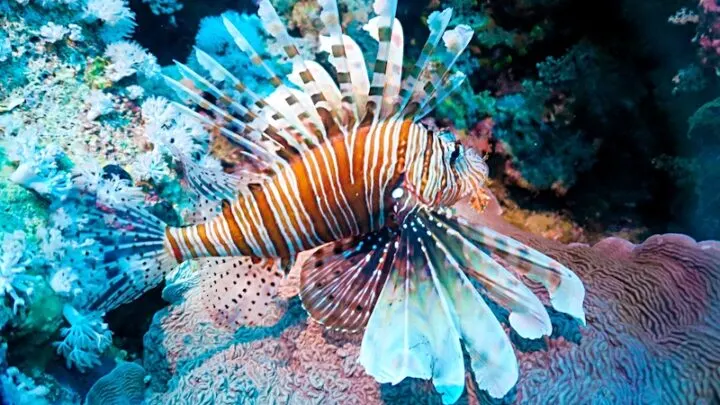We believe being a scuba diver is not just about admiring what’s in the ocean but learning about them too, and there’s some fish that capture our attentions more than others. Let’s talk about the Lionfish, a beautiful, yet invasive fish that has a lot more to it than the way it looks.
Lionfish are known as the perfect super invader for several reasons; they reproduce rapidly, grow quickly, disperse readily on the ocean currents, tolerate a variety of habitats and have few natural enemies. Thriving in their new habitat in the Caribbean and Gulf of Mexico, they grow roughly a third larger than their native species and the population density can be up to 5 times greater. There are major concerns for the impact on native hard bottom, mangrove, seagrass and coral reef fish communities. The concern is not only the predation of lionfish on local native fish and the competition for a common food source but the cascading effects throughout the entire ecosystem.
Taxonomy and Anatomy
There are twelve types of Lionfish, the most common are the Red Lionfish (Pterois Volitan) and the Devil Firefish. (Pterois Miles). There is little difference between the two, making it hard to tell them apart and often both species are referred to as Red Lionfish.
Red lionfish have large feathery fins that protrude from the body and spiny spikes on the head, venomous spines in the dorsal, anal and pelvic fins. Their coloration varies but they are characterized by bold narrow vertical stripes or bands of red, maroon or red brown with white or yellowish bands in between with spotted fin.
Males and females are similar in coloration except during breeding which tends to be when they conjugate in smaller groups. The adults are primarily solitary and may remain in one location until food sources are depleted. They are slow moving are primarily nocturnal/ They can be found under ledges and in crevices during the day but come out to hunt during the evenings.
Where have they come from?
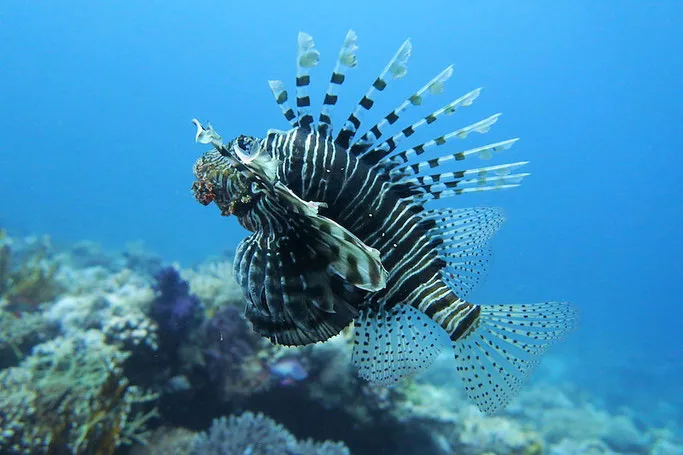
The Red Lionfish that is considered invasive is native to the Indian and Pacific Oceans, and are a recent addition to the Caribbean, Gulf of Mexico and other parts of the Atlantic as far north as North Carolina and south to Uruguay. They were first sighted here as early as 1985 and believed to be the results of breeding pairs being released from aquariums and others hitching rides on freighters from their native habitat.
Lionfish hunting strategies
The larger juveniles and adults consume small fish, shrimp, crabs and other invertebrates usually smaller than 4 inches and they can quickly wipe out a reef of its small and juvenile fish in a matter of days. They catch their prey by spreading their pectoral fins and corralling them, or they direct squirts of water at their intended prey to confusing the fish and cause them to align themselves with the moving water thus making it again easier to catch the prey headfirst.
Why are lionfish such a successful invasive species?
Lionfish reproduce extremely fast, they reach adulthood in less than a year and spawn year round. Females can spawn as often as every 3-4 days if the conditions are right and they produce up to 2 million eggs per year. Males will mate with several females and spawning occurs at the surface with the males immediately fertilizing the released eggs. The eggs hatch within 36 hours and may spend 30 days floating close to the surface which allows for very wide dispersal on the currents. This has resulted in very rapid expansion throughout the Atlantic and Caribbean. Lionfish are thought to live around 10 years but have been known to live up the 35 years in captivity.
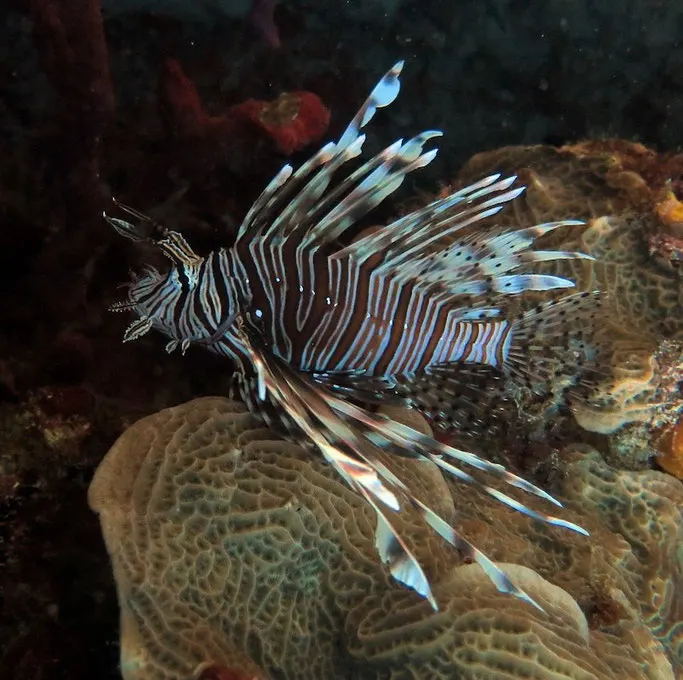
Issues caused by the invasive Red Lionfish
The impact from these fish occurs mostly at the ecological level but there is also an economic impact. Not only is this species reducing the abundance of native fish, they are seriously threatening the impact on commercial activities such as tourism and fisheries. Control is a big problem as they have no natural predators but they have recently been found in the stomachs of groupers, and nurse sharks are starting to see them as a potential food source. Some areas have promoted lionfish hunts to try and control the population and in many Scuba diving areas people are encouraged to spearfish them. Many of the dive guides will carry small spears to kill what they find discreetly as to not offend other divers. Some dive shops are promoting lionfish hunts as specialized dives. You can help by either taking part in hunting them or making sure you report any sightings so there is a better idea of where they are colonizing. It has been found that hunting them it is an effective way of decreasing the negative impact of lionfish in certain areas. Marine parks in Mexico, Florida Keys, Cayman, Bonaire, and many others are actively involved in controlling lionfish expansion. However, because of the species capacity to move easily between sites, it is making it difficult for coordination and collaboration nationally and regionally.
As divers, it can be difficult to come around to the idea of spearing and killing fish during dives but here’s some food for thought:
- What effect might a significant reduction in cleaner fish and shrimp have on the current fish population?
- How will it affect the populations of native fish when a large portion of their juveniles are being consumed?
- How will the corals survive if lionfish eat a large portion of the herbivorous fish that keep the seaweed and algae from overgrowing?
Responsible Lionfish hunting
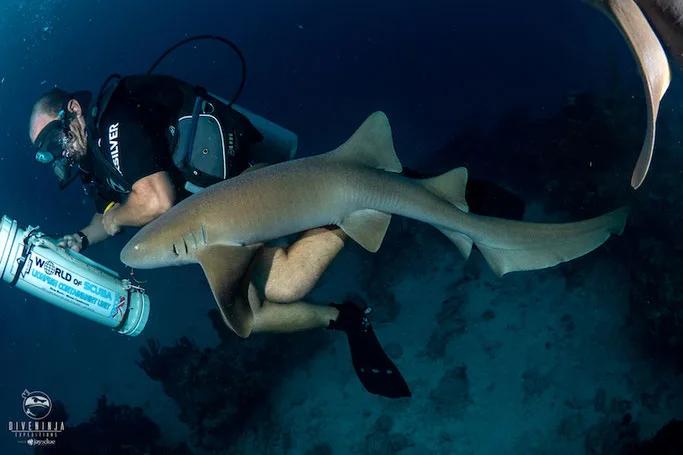
Before actively taking part in reducing lionfish numbers, there are some key factors to consider:
- Lionfish are venomous, the venom is delivered by an array of needle like dorsal fins.
- If stung, the venom is painful and can cause nausea, breathing problems, inflammation, abdominal pain, seizures and loss of consciousness.
- People rarely die from being stung, but anyone with a sensitivity to bee stings etc. could have a more acute reaction.
- Have the proper equipment for this activity, such as a zookeeper to put them in. There are many types of spear out there, ask someone what the best ones are for this type of fishing.
- Go with someone (or a dive centre) who knows the local area, are experienced divers and who are experienced in spearing lionfish.
What else can you do
If hunting is not for you then check with the local authorities for their protocol for reducing the Lionfish population. Being aware of the problem and acting even in small ways can make a big difference. You can also just be a spotter for those who are actively spearfishing because Lionfish can be hard to see in the daytime. The saying “two sets of eyes are better than one” applies here 10 fold.
In certain areas where hunting is going on, there are often restaurants getting on board by teaming up with divers and offering incentives for catching fish. Lionfish are great to eat and can be an excellent choice in terms of sustainability.
As divers we promote the protection of all sea life but unfortunately this is a case where if we do not act, the oceans in our home areas will never be the same once this invasive species takes hold. Soon the reefs will have no small fish or creatures and then the larger individuals will vanish.
For a more in-depth study of lionfish check out: “Depth-dependent effects of culling—do mesophotic lionfish populations undermine current management?”
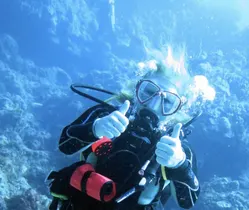
Kelly Bossons owns and operates a rental Villa in Playa Del Carmen Mexico Where she spends most of her time under the water or walking on the sandy beaches with her two dogs Kelly discovered diving at the young age of 54 and has since gone on to achieve her Divemaster certification. You can find out more about her on facebook.com/sassyscubagirl and www.instagram.com/sassyscubagirl

